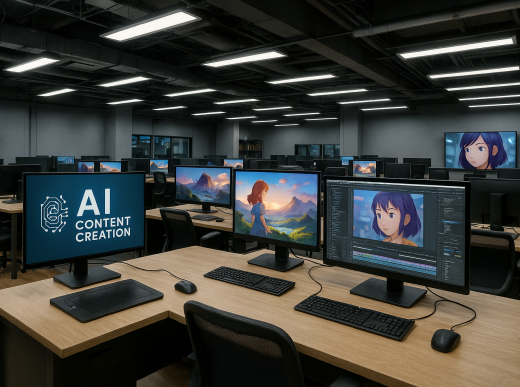SILICON VALLEY – The artificial intelligence chip market is experiencing unprecedented competition as NVIDIA Corporation (NASDAQ: NVDA), Advanced Micro Devices, Inc. (NASDAQ: AMD), and Intel Corporation (NASDAQ: INTC) engage in an intense battle for dominance in the rapidly growing AI semiconductor sector, with billions in revenue and technological leadership at stake.
NVIDIA Maintains Market Leadership Despite Growing Competition
NVIDIA continues to dominate the AI chip landscape with its data center GPU portfolio, capturing approximately 80% of the AI training market. The company’s latest H100 Tensor Core GPUs and upcoming B200 “Blackwell” architecture represent the current gold standard for large language model training and inference.
Recent earnings reports show NVIDIA’s data center revenue reaching $47.5 billion annually, with demand far exceeding supply. Major cloud providers including Amazon Web Services, Google Cloud, and Microsoft Azure continue to place massive orders for NVIDIA’s AI accelerators.
AMD’s Strategic Challenge to NVIDIA’s Dominance
AMD has emerged as NVIDIA’s most credible challenger with its MI300 series AI accelerators. The MI300X offers 192GB of high-bandwidth memory, significantly more than NVIDIA’s H100, making it attractive for large-scale AI workloads.
CEO Lisa Su has positioned AMD as the “open alternative” to NVIDIA’s proprietary CUDA ecosystem, promoting the open-source ROCm platform and industry-standard software frameworks.
Key partnerships with Meta Platforms, Microsoft, and Oracle have provided AMD with crucial validation and deployment opportunities. The company projects AI accelerator revenue to reach $4.5 billion in 2025, representing 400% growth from the previous year.
Intel’s Ambitious Comeback Strategy
Intel is mounting an aggressive comeback with its Gaudi AI accelerator family and upcoming Falcon Shores architecture. The Gaudi3 processors promise significant cost advantages over competing solutions while maintaining competitive performance for AI training and inference.
Under CEO Pat Gelsinger’s leadership, Intel has invested heavily in AI software optimization, partnering with leading AI frameworks including PyTorch, TensorFlow, and Hugging Face to ensure broad ecosystem compatibility.
Market Dynamics and Customer Strategies
The intense competition has created a multi-vendor procurement strategy among major AI companies. OpenAI, Anthropic, and other leading AI developers are diversifying their hardware dependencies to avoid single-vendor lock-in and negotiate better pricing.
Meta’s recent announcement of custom AI chips developed in partnership with Broadcom represents another competitive threat, as hyperscale companies increasingly develop proprietary silicon solutions.
Software Ecosystem: The Critical Battleground
While hardware performance remains crucial, the software ecosystem has emerged as the decisive competitive factor. NVIDIA’s CUDA platform maintains a significant advantage with over 4 million registered developers and extensive optimization for popular AI frameworks.
AMD’s ROCm initiative and Intel’s oneAPI toolkit represent ambitious attempts to create competitive software ecosystems, but both face the challenge of overcoming CUDA’s established developer mindshare.
Emerging Technologies and Future Competition
The competitive landscape continues evolving with emerging technologies including quantum computing accelerators, neuromorphic chips, and specialized inference processors. Companies like Cerebras Systems, Graphcore, and SambaNova Systems are developing innovative architectures that could disrupt the current market dynamics.
Apple’s M-series chips with integrated Neural Engines and Google’s Tensor Processing Units (TPUs) demonstrate how major technology companies are developing custom AI silicon to reduce dependence on traditional GPU vendors.
Supply Chain and Manufacturing Considerations
The AI chip war is complicated by global semiconductor supply chain constraints and geopolitical tensions. All three major competitors rely heavily on Taiwan Semiconductor Manufacturing Company (TSMC) for advanced node production, creating potential bottlenecks and strategic vulnerabilities.
Recent U.S. export restrictions on AI chips to China have forced companies to develop specialized products for different markets, adding complexity to product development and go-to-market strategies.
Financial Impact and Market Projections
Industry analysts project the AI chip market will reach $400 billion by 2027, with data center AI accelerators representing the largest segment. This massive opportunity has attracted significant investment, with venture capital firms pouring billions into AI chip startups and established companies expanding their AI-focused R&D budgets.
The competition has also driven rapid innovation cycles, with new product generations launching every 12-18 months compared to traditional 3-4 year cycles in other semiconductor segments.
Strategic Implications for the Industry
The AI chip wars represent more than a simple hardware competition – they will determine which companies control the fundamental infrastructure powering the next generation of artificial intelligence applications. Success in this market will influence everything from autonomous vehicles and robotics to scientific research and national security applications.
As the competition intensifies, customers benefit from improved performance, lower costs, and greater choice. However, the rapid pace of innovation also creates challenges for AI developers who must navigate an increasingly complex landscape of hardware options and software frameworks.
The ultimate winners in this battle will be determined not just by raw computational performance, but by their ability to create comprehensive ecosystems that enable developers to efficiently build, deploy, and scale AI applications across diverse use cases and deployment environments.
















